Welcome to our comprehensive guide on tiger lotus bulbs, the aquatic plant bulbs that can transform your aquarium into a mesmerizing oasis.
These stunning bulbs, also known as nymphaea zenkeri bulbs, are renowned for their vibrant colors and elegant appearance.
Whether you’re a beginner or an experienced aquarist, this article will equip you with all the information you need to care for and cultivate flourishing tiger lotus bulbs in your freshwater aquarium.
The following sections will dive into the biological characteristics of the nymphaea zenkeri bulb, the benefits of incorporating tiger lotus into aquatic ecosystems, and step-by-step instructions for planting and maintaining these beautiful bulbs.
From selecting the perfect location to understanding the growth cycle, fertilization strategies, and trimming techniques, we’ll cover it all.
Key Takeaway
- Tiger lotus bulbs are aquatic plant bulbs that can add vibrant colors and elegance to your aquarium.
- The nymphaea zenkeri bulb is native to Africa and offers several benefits to aquatic ecosystems.
- Proper planting, care, and maintenance are crucial for the success of tiger lotus bulbs in your aquarium.
- Tiger lotus bulbs come in various colors, including green and red, allowing for unique underwater landscapes.
- Understanding the growth cycle and employing fertilization strategies are key to promoting optimal growth.

Quick Stats
| Attribute | Details |
| Family Name | Nymphaeaceae |
| Common Name | Tiger Lotus Bulbs |
| Origin | Tropical regions of Africa and Asia |
| Height | 15-45 cm (6-18 inches) |
| pH Range | 6.0 – 7.5 |
| CO2 Requirement | Low to Moderate |
| Growth Rate | Moderate to Fast |
| Care Level | Moderate to Difficult |
| Color Form | Green, with red or brown spots; varieties also include green and red leaf forms |
| Water Conditions | 22-28°C (72-82°F), adaptable to a range of water hardness |
| Max Size | Leaves can reach up to 20-30 cm (8-12 inches) in diameter |
| Lighting | Moderate to High |
| Supplements | Requires nutrient-rich substrate and regular dosing of liquid fertilizers |
| Placement | Background to Mid-ground |
| Propagation | Through bulb division or seeds |
What Is Tiger Lotus Bulb?
Tiger lotus bulbs, also known as nymphaea zenkeri bulbs, belong to the water lily family and are native to the tropical waters of Africa.
These aquatic plant bulbs are highly regarded for their stunning beauty and adaptability to various water conditions.
The nymphaea zenkeri bulb exhibits several biological characteristics that contribute to its appeal as an aquarium plant.
Its vibrant colors, broad leaves, and ability to produce fragrant flowers make it a visually captivating addition to any aquatic environment.
Besides their aesthetic appeal, tiger lotus bulbs offer numerous benefits to aquatic ecosystems. They aid in oxygenation, contribute to natural filtration, and provide coverage and shelter for fish.

History And Origin
The history and origin of tiger lotus bulbs can be traced back to their native African habitat.
These aquatic plants have been cultivated and appreciated for their beauty for centuries.
The exact origin of the nymphaea zenkeri bulb is still debated among experts, but it is believed to have originated in West Africa.
Over time, tiger lotus bulbs have gained popularity among aquarists worldwide and are now widely available in the aquarium trade.
Understanding the history and origin of these bulbs can enhance your Appreciation for their beauty and cultural significance.
Physical Characteristics
- Bulb: Tiger Lotus plants grow from a specialized bulb, which serves as the storage organ for nutrients. These bulbs are typically round or oval-shaped and can vary in size depending on the age and maturity of the plant. The bulb is the starting point for the growth of the Tiger Lotus plant and contains the initial nutrients necessary for sprouting and development.
- Leaves: Once the bulb sprouts, Tiger Lotus plants produce large, round leaves that float on the surface of the water. The leaves are typically green with red or purple undersides, although some varieties may exhibit different coloration. The leaves can vary in size, with mature plants producing larger leaves that can reach several inches in diameter.
- Stems: Tiger Lotus plants also produce long, slender stems that extend from the bulb and anchor the plant in the substrate. These stems may be green or reddish-brown in color and provide structural support for the floating leaves. The stems can grow vertically or diagonally depending on the environmental conditions and growth pattern of the plant.
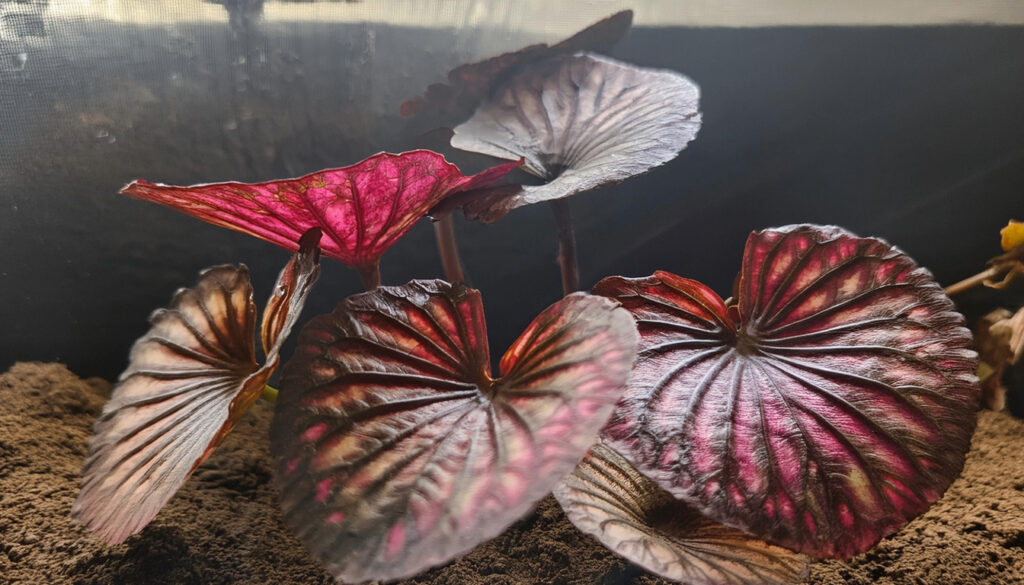
Lighting Needs
- Moderate to High Intensity: Tiger Lotus plants generally thrive under moderate to high-intensity lighting. Provide a lighting setup that delivers sufficient brightness to penetrate the water and reach the bottom of the aquarium where the Tiger Lotus bulbs are planted. LED or fluorescent lighting fixtures are commonly used in planted aquariums and can provide the necessary intensity for healthy Tiger Lotus growth.
- Full Spectrum: Use lighting fixtures that emit a full spectrum of wavelengths, including red, blue, and green light, to support photosynthesis and overall plant health. Full-spectrum lighting helps promote vibrant foliage and may enhance the coloration of Tiger Lotus leaves and flowers.
- Duration: Provide a consistent lighting duration of 8 to 10 hours per day to simulate natural daylight cycles. Avoid excessive or prolonged lighting periods, as this can encourage algae growth and may stress the Tiger Lotus plants. Use a timer to automate the lighting schedule and ensure consistent photoperiods for the plants.
Temperature Parameters
- Temperature Range: The optimal temperature range for Tiger Lotus bulbs typically falls between 22°C to 28°C (72°F to 82°F). This temperature range mimics the warm, tropical conditions found in their native habitats and promotes healthy growth and development of the bulbs and their associated plants.
- Stability: Maintain stable water temperatures within the recommended range to prevent temperature fluctuations that can stress the Tiger Lotus bulbs and inhibit their growth. Sudden changes in temperature can disrupt the biological processes of the bulbs and may lead to adverse effects such as wilting or rotting.
- Heating Equipment: Use a reliable aquarium heater to regulate water temperature and ensure consistency throughout the aquarium. Choose a heater appropriate for the size of your tank and place it in an area with good water circulation to distribute heat evenly. Monitor the temperature regularly using a thermometer to ensure it remains within the optimal range.
Optimal Water Condition
- pH Level: Tiger Lotus bulbs prefer slightly acidic to neutral water conditions. Aim for a pH level between 6.5 to 7.5 to promote healthy growth and development. Regularly monitor the pH level using a reliable aquarium test kit and make adjustments as needed to maintain stability.
- Water Hardness: Tiger Lotus bulbs can tolerate a wide range of water hardness levels, but they generally prefer moderately soft to moderately hard water. Aim for a general hardness (GH) level between 4 to 15 dGH (degree of general hardness) and a carbonate hardness (KH) level between 3 to 8 dKH (degree of carbonate hardness).
- Temperature: Maintain stable water temperatures within the optimal range for Tiger Lotus bulbs, which typically falls between 22°C to 28°C (72°F to 82°F). Use a reliable aquarium heater to regulate water temperature and prevent fluctuations that can stress the bulbs and inhibit their growth.
RELATED: Nurturing Hydrocotyle Leucocephala (Brazilian Pennywort) At Your Homely Aquascape
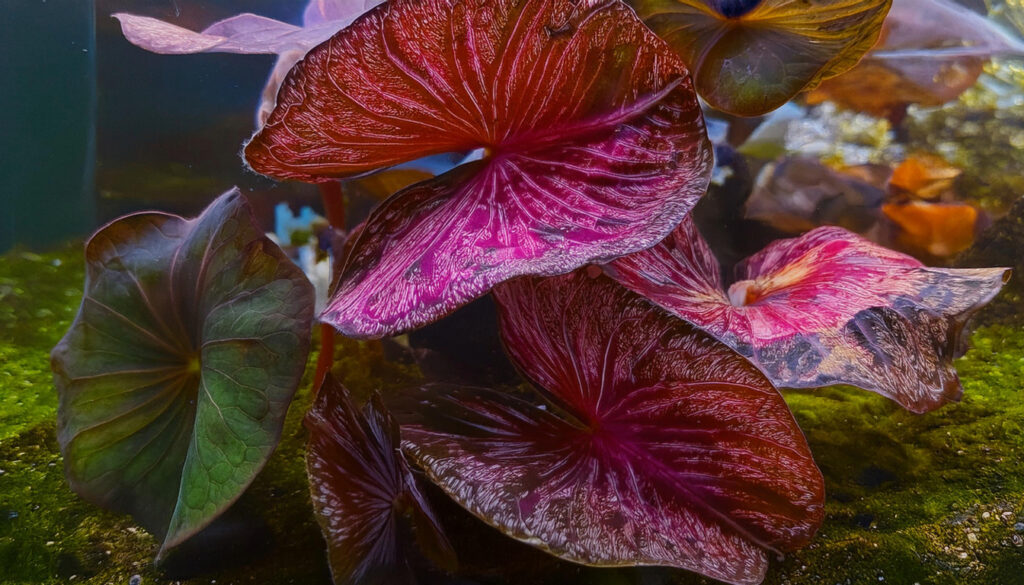
Substrate Requirements For Planting Tiger Lotus Bulbs
The substrate is the material that forms the bottom layer of your aquarium.
A nutrient-rich substrate is crucial for tiger lotus bulbs’ overall health and growth.
Consider using a substrate specifically formulated for aquatic plants that contain essential nutrients such as iron and trace elements.
This will provide a solid foundation for the bulb’s roots to anchor and absorb essential nutrients.
Tiger lotus bulbs have specific depth requirements that should be considered during planting.
These bulbs should generally be planted at a depth of 1-2 inches (2.5-5 cm) in the substrate.
Planting them too deep may result in delayed growth or difficulty in establishing roots, while planting them too shallow may expose the bulb and lead to damage.
It’s essential to find the right balance and ensure the bulb is securely planted at the appropriate depth.
Placement Option
- Foreground: Tiger Lotus bulbs can be placed in the foreground of the aquarium to create a focal point and add visual interest. Plant the bulbs directly into the substrate, leaving enough space between them to allow for growth and expansion. The foreground placement can help showcase the unique foliage and vibrant colors of the Tiger Lotus leaves.
- Midground: Alternatively, Tiger Lotus bulbs can be positioned in the midground area of the aquarium to complement other aquatic plants and create depth in the aquascape. Plant the bulbs amidst other plants or hardscape elements to create a naturalistic setting. This placement option allows the Tiger Lotus leaves to reach towards the water surface while providing a backdrop of greenery.
- Background: Tiger Lotus bulbs can also be placed in the background of the aquarium to serve as a backdrop for taller plants or hardscape features. Plant the bulbs towards the back of the tank and allow the leaves to grow upwards towards the water surface. This placement option adds vertical dimension to the aquascape and creates a lush, jungle-like atmosphere.
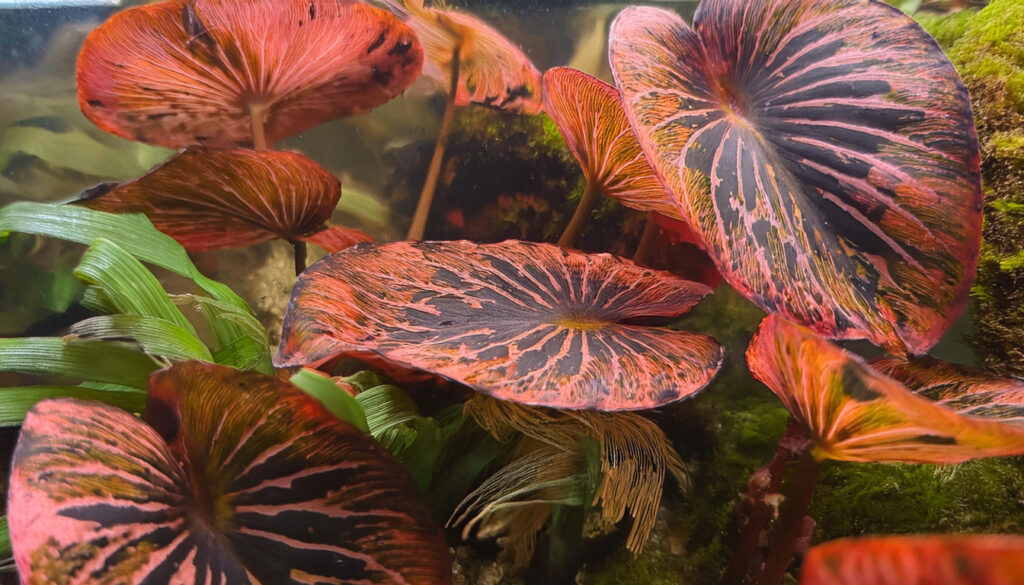
Recommended Tank Size
- Bulb Size: Tiger Lotus bulbs can vary in size, with larger bulbs typically producing larger plants with more expansive foliage. Consider the size of the bulbs you plan to use when selecting a tank size, as larger bulbs may require more space to accommodate their growth.
- Number of Bulbs: Decide how many Tiger Lotus bulbs you want to plant in your aquarium and consider how much space each bulb will need to grow and spread. Space the bulbs evenly throughout the tank to create a balanced and visually appealing layout.
- Aquascape Design: Consider the overall design and layout of your aquarium when choosing a tank size for Tiger Lotus bulbs. Smaller tanks may limit the number of bulbs you can plant and may require more frequent maintenance to prevent overcrowding. Larger tanks offer more flexibility and space for planting multiple bulbs and creating intricate aquascapes.
- Compatibility: Take into account the compatibility of Tiger Lotus bulbs with other aquatic plants and fish species in the aquarium. Ensure that the tank size is suitable for the species you intend to keep and provides ample space for their growth and movement, while still allowing room for the Tiger Lotus bulbs to thrive and spread.
RELATED: The Perfect Growing Guide Of Isoetes Velata For Beginner Gardeners
Pairing Tiger Lotus With Companion Plants
Companion planting is a popular practice in gardening, and it can also be applied to aquariums.
Pairing tiger lotus with compatible companion plants can enhance the overall aesthetic and functionality of your aquarium.
When selecting companion plants for your tiger lotus bulb, consider their growth habits, nutrient requirements, and compatibility.
Choose plants that have similar water and lighting requirements to ensure they thrive together in the same aquatic environment.
Some suitable companion plants for tiger lotus bulbs include:
- Java Fern (Microsorum pteropus)
- Anubias (Anubias sp.)
- Cryptocoryne (Cryptocoryne sp.)
- Dwarf Sagittaria (Sagittaria subulata)
- Rotala (Rotala sp.)
These plants offer a variety of leaf textures, colors, and growth habits that complement the elegant beauty of the tiger lotus.
They also have similar care requirements, making managing their growth easier and maintaining a harmonious aquascape.
Nutritional Needs
- Macronutrients: Tiger Lotus bulbs require essential macronutrients such as nitrogen (N), phosphorus (P), and potassium (K) for healthy growth and development. These macronutrients play vital roles in various physiological processes, including photosynthesis, cell division, and overall plant metabolism. Macronutrients can be provided through fish waste, decaying organic matter, and water column fertilization.
- Micronutrients: In addition to macronutrients, Tiger Lotus bulbs also require trace elements or micronutrients for optimal growth and nutrient uptake. These micronutrients include iron (Fe), manganese (Mn), zinc (Zn), copper (Cu), and others. Micronutrients are essential for enzyme function, chlorophyll synthesis, and overall plant health. Micronutrients can be provided through water column fertilization or substrate supplements.
- Carbon Dioxide (CO2): Tiger Lotus bulbs utilize carbon dioxide during photosynthesis to produce carbohydrates and oxygen. While CO2 can be obtained from the surrounding water column and through substrate decomposition, supplemental CO2 injection or liquid carbon supplementation may enhance growth rates and promote lush foliage in high-tech planted aquarium setups.
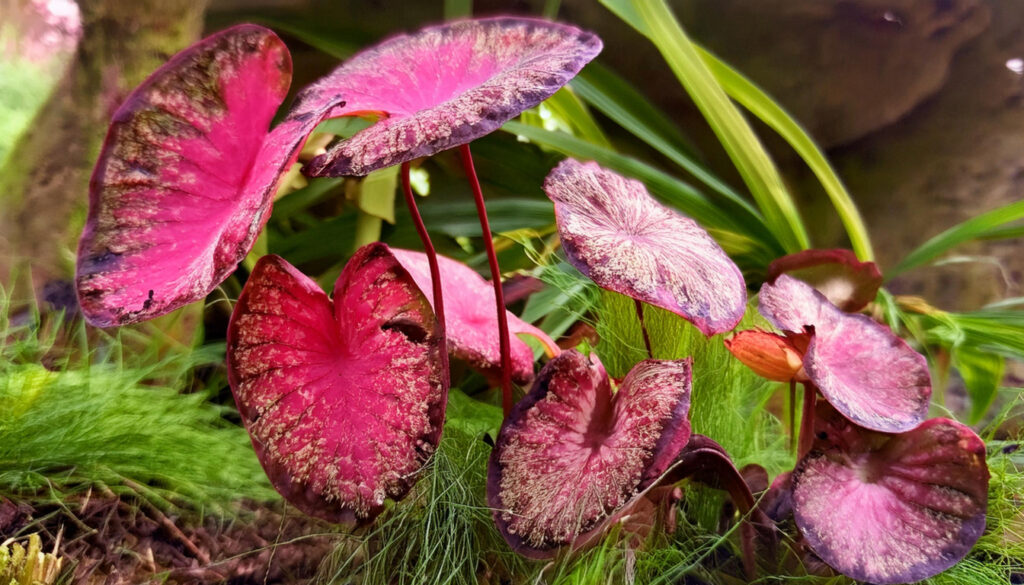
Tiger Lotus Bulbs Cultivation Tips
- Nutrient Supplementation: Supplement with liquid or substrate fertilizers to provide essential nutrients for the bulbs. Ensure a balanced nutrient profile, including macro and micronutrients, to support healthy growth and development. Pay attention to signs of nutrient deficiency, such as yellowing or stunted growth, and adjust fertilization accordingly.
- Pruning and Maintenance: Regularly trim dead or decaying leaves and remove any debris or detritus that accumulates around the bulbs to prevent rotting and maintain water quality. Prune overgrown leaves to promote new growth and maintain the desired shape of the plants.
- Propagation: Tiger Lotus bulbs can propagate by producing offshoots or “runners” that sprout new plants. Allow these offshoots to develop and establish themselves in the substrate, or carefully detach them and replant them elsewhere in the aquarium.
- Patience: Be patient and allow time for Tiger Lotus bulbs to acclimate and sprout after planting. It may take several weeks for bulbs to produce new growth, so continue to provide proper care and maintenance while waiting for signs of sprouting.
Plant Propagation Tips
- Offshoots: Tiger Lotus bulbs often produce offshoots or “runners” that sprout new plants. These offshoots can be allowed to develop and establish themselves in the substrate, or they can be carefully detached and replanted elsewhere in the aquarium. Look for small plantlets emerging from the base of mature Tiger Lotus plants and gently separate them from the parent plant using sharp scissors or aquascaping tools. Plant the offshoots in the substrate, ensuring that the roots are buried and the leaves are above the substrate surface.
- Division: Mature Tiger Lotus bulbs can be divided into multiple sections to propagate new plants. Wait until the bulb has produced multiple stems and leaves before dividing it. Carefully remove the bulb from the substrate and use a sharp knife or scissors to divide it into smaller sections, ensuring that each section has at least one stem and a portion of the rhizome. Plant the divided sections in the substrate, making sure to cover the roots and leave the leaves exposed above the substrate surface.
- Seed Propagation: Tiger Lotus bulbs can also be propagated from seeds, although this method is less commonly used in aquariums. Collect mature seeds from flowering Tiger Lotus plants and sow them in a suitable growing medium, such as aquatic soil or gravel substrate. Keep the growing medium moist and provide moderate lighting and warm temperatures to encourage germination. Once the seeds have germinated and produced seedlings, transplant them into the aquarium substrate and continue to provide proper care and maintenance.
Benefits Of Tiger Lotus In Aquatic Ecosystems
- Oxygenation: The plants release oxygen during photosynthesis, contributing to the overall oxygen levels in the water.
- Natural filtration: The roots of tiger lotus bulbs act as natural filters, absorbing excess nutrients and potentially harmful substances from the water.
- Coverage and shelter: The broad leaves and dense growth provide coverage and shelter for fish and other aquatic organisms, creating a more natural and secure habitat.
| Biological Characteristics | Benefits in Aquatic Ecosystems |
| Vibrant colors, broad leaves, fragrant flowers | Oxygenation, natural filtration, coverage and shelter for fish |
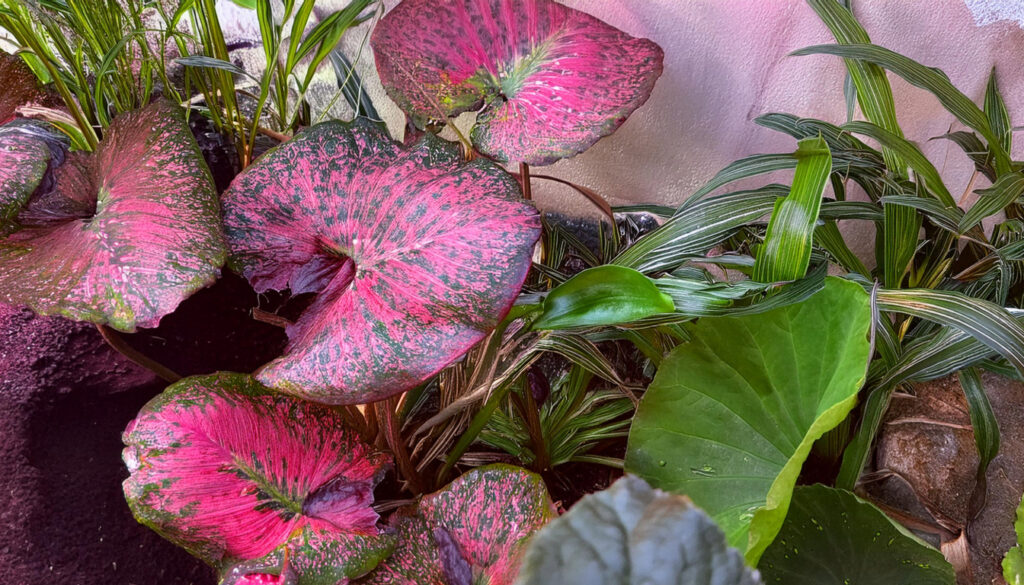
Conclusion
Tiger lotus bulbs are a captivating addition to any aquarium.
Their vibrant colors and elegant beauty can transform your underwater world into a mesmerizing oasis.
Not only do these aquatic plant bulbs enhance the aesthetic appeal of your aquarium, but they also offer numerous benefits to the aquatic ecosystem.
By following our step-by-step planting guide and implementing best practices for care, you can cultivate and maintain healthy tiger lotus bulbs in your aquatic environment.
Understanding the growth cycle, fertilization strategies, and trimming techniques will further support the growth and longevity of these beautiful bulbs.
Whether you’re a beginner or a seasoned aquarist, with the right knowledge and care, you can enjoy the blooming beauty of tiger lotus bulbs in your aquarium for years to come.
So why wait? Dive into the world of tiger lotus bulbs and bring their splendor into your aquarium.
With their vibrant colors, elegant appearance, and myriad benefits, these aquatic plant bulbs are sure to delight both you and your fish.
Start your tiger lotus journey today and create a captivating underwater oasis for everyone to enjoy!
Frequently Asked Questions
What Are The Different Colors Of Tiger Lotus Bulbs?
Tiger lotus bulbs come in a variety of colors, with green and red being the most common options available in the aquarium trade.
How Do I Care For My Tiger Lotus Bulb?
Caring for your tiger lotus bulb involves providing the right lighting and temperature conditions, fertilization, and pruning techniques.
For detailed instructions, follow our best practices and care tips.
What Is The Growth Cycle Of The Nymphaea Lotus Bulb?
The growth cycle of the nymphaea lotus bulb includes stages such as germination, plant development, and flowering.
Understanding this cycle will help you provide the necessary care and conditions for each stage of growth.
What Fertilization Strategies Should I Use For My Tiger Lotus Bulb?
You can employ fertilization strategies and proper planting techniques for your tiger lotus bulb to promote optimal growth.
This includes considering substrate and depth requirements. Follow our detailed instructions for effective fertilization.
How do I manage the growth of my tiger lotus bulb?
To manage the growth of your tiger lotus bulb, you should trim and prune it regularly to prevent overgrowth and maintain its desired shape.
Additionally, create a sustainable aquatic habitat by ensuring proper water quality and consider pairing it with companion plants for enhanced aesthetics and functionality.
- Unveiling The Wonders Of Riccia Fluitans In Aquascapes - August 7, 2024
- Vallisneria Gigantea Var. Guide To Care And Cultivation At Home - July 31, 2024
- Vesicularia Dubyana Care & Growth Guide Tips For Beginner Gardeners - July 30, 2024
